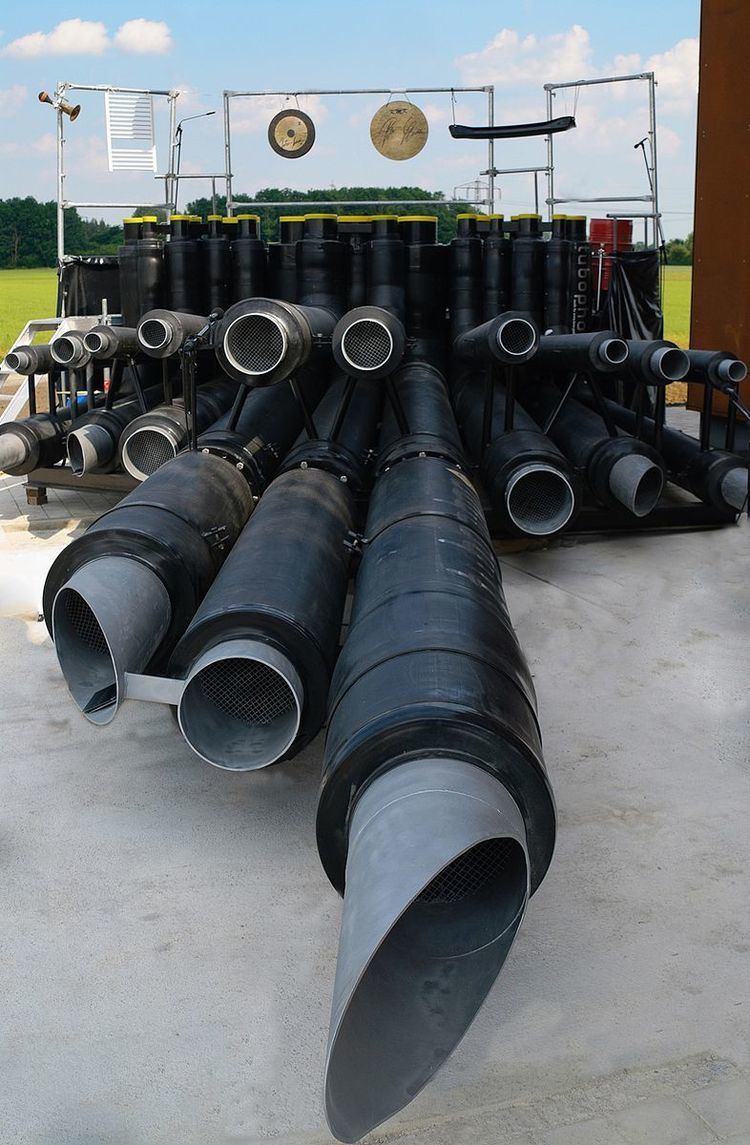Classification Percussion | Developed 2004-present | |
 | ||
Hornbostel–Sachs classification 211.211.1
(Tubular drums in which the end without a membrane is open) Inventor(s) Stefan Schubert, Peter Sadlo | ||
The Tubophon is a musical instrument belonging to the family of percussion instruments.
Contents
Name
Tubophon: Consisting of the words tubo = tube, pipe (Latin – tubus) and phon = loud, sound (Greek – phonos)
History
The history of the Tubophon started in 2004 when engineer Stefan Schubert discovered by accident the sound characteristics of district heating steel tubes covered with plastic caps. The unique archaic sound inspired Schubert to construct a percussion instrument comprising different tube lengths and thicknesses. Together with Prof. Peter Sadlo he built a prototype for the musical highlight during the inauguration of the geothermal energy project in Pullach/ Germany. The device, then known as a "Geothermiephon" ("geothermics phone") however, was disassembled again and the further development was stopped for cost reasons.
In 2010 the financial and constructional music project started anew. A new, transportable building concept made it possible that within six weeks more than 160 m of tubes were welded to each other with the help of heavy-duty lifting equipment. In his advisory capacity Prof. Peter Sadlo again contributed with many suggestions and ideas regarding the playability and the pitch range. However, the way of proceeding was rather more experimental than predictable.
On 25 June 2010 the Tubophon was played for the first time by Prof. Peter Sadlo and Doubledrums at the inauguration of the geothermal energy centre in Unterföhring.
In 2011 it was registered as an industrial design with the German Patent and Trademark Office.
Construction and design
The Tubophon consists mainly of steel tubes with a plastic coating and thermal insulation, such as are used for district heating networks. 19 different tones are produced from 125 m of tube. The tubes are sealed at the playing end with a plastic cap as a drumhead, the other ends of the tubes are open. The design developed by graphic designer Michael Wladarsch with its chamfers and angles is reminiscent of an organ laid flat, the silver and partially elliptically cut off end pieces of the big "sidepipes" are reminiscent of large-bore exhaust pipes. The final painting of the silver tubes with a black coating is reflected in the Tubophon lettering. The final metal work for the subframe and the cross struts separated the construction into four modules, each weighing between one and two tons. The Tubophon is transported on a lorry with a mobile crane for each module.
Playing technique
Like other percussion instruments the Tubophon is played with drumsticks or mallets striking the drumheads (plastic caps). The tubes themselves do not resonate but it is the air pressure created that produces the tone. With small, short tubes explosive, high tones or even shell-like beats are produced when the drumhead is struck. With the large, long tubes sometimes several base tones with several overtones are produced, depending on the stroke technique. It is difficult to describe the sound that is created, but this is what makes the instrument unique. In its present construction the tones cannot be retuned. The independent dynamics and physical presence of the tones makes recording onto recording mediums difficult if not impossible.
